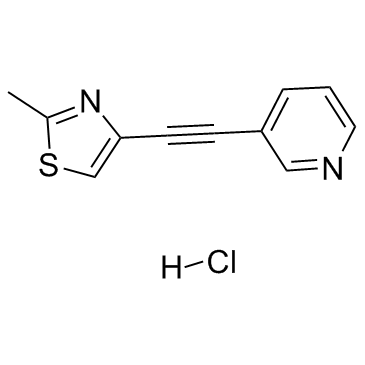1186195-60-7
| Name | 2-methyl-4-(2-pyridin-3-ylethynyl)-1,3-thiazole,hydrochloride |
|---|---|
| Synonyms |
3-[(2-Methyl-1,3-thiazol-4-yl)ethynyl]pyridine hydrochloride (1:1)
CS-1249 MTEP hydrochloride Pyridine, 3-[2-(2-methyl-4-thiazolyl)ethynyl]-, hydrochloride (1:1) 3-[(2-methyl-1,3-thiazol-4-yl)ethynyl]pyridine hydrochloride MTEP hydrochloride||MTEP MTEP (hydrochloride) |
| Description | MTEP Hcl is a potent, selective and non-competitive mGlu5 antagonist with IC50 and Ki of 5 nM and 16 nM, respectively. IC50 Value: 5 nM [1]Target: mGluR5MTEP occupied mGlu5 receptors in a dose-dependent manner with essentially full receptor occupancy at the highest dose tested (10 mg/kg, i.p.). At doses appropriate for mGlu5 receptor-mediated effects, MTEP significantly reduced fear-potentiated startle and increased punished responding in a modified Geller-Seifter conflict model consistent with an anxiolytic-like profile. MTEP decreased unpunished responding to a lesser extent than diazepam and had no effect on rotarod performance when administered either alone or in combination with ethanol. Repeated dosing with MTEP in this model eliminated the increase in punished responding observed with acute dosing. |
|---|---|
| Related Catalog | |
| References |
| Molecular Formula | C11H9ClN2S |
|---|---|
| Molecular Weight | 236.721 |
| Exact Mass | 236.017502 |
| PSA | 54.02000 |
| LogP | 3.04830 |
| Storage condition | 2-8℃ |
